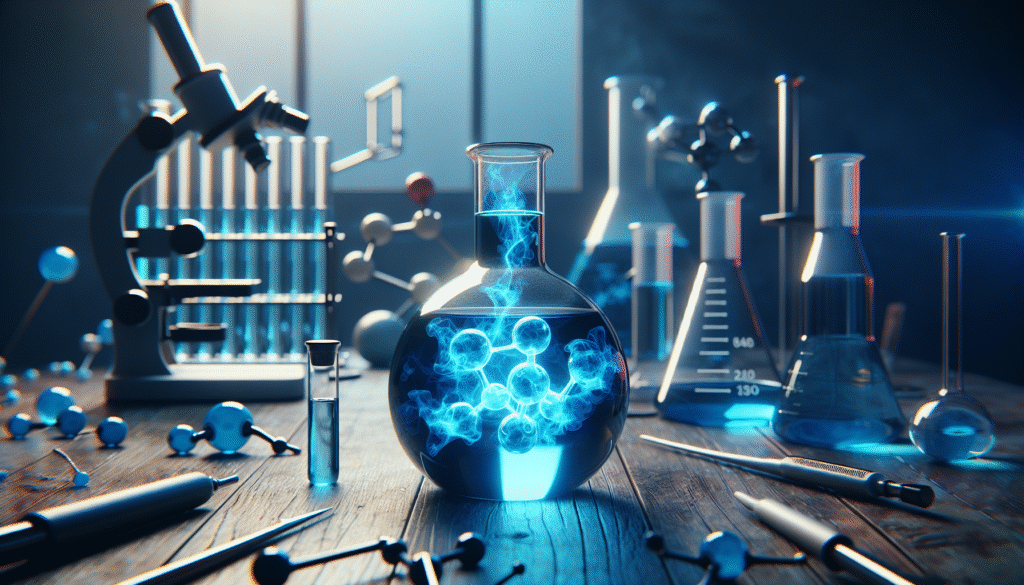
Have you ever wondered about the significance of Methylene Blue in biochemistry education and its broader implications in scientific research?
Introduction to Methylene Blue
Methylene Blue (MB) is a thiazine dye, well-known not only for its coloring properties but also for its roles within biological systems. Originally synthesized in the late 19th century, it has since found diverse applications across various fields. This article will explore the multifaceted applications of Methylene Blue in biochemistry education, examining its uses, mechanisms of action, and potential implications for teaching and research.
Methylene Blue serves not only as a dye but also as a redox agent. It engages with biological processes, making it an intriguing subject for biochemistry learners. As you delve deeper into its functions and educational applications, a clearer picture of how Methylene Blue can enhance your understanding of biochemical principles emerges.
Historical Context of Methylene Blue
The Discovery and Development
Methylene Blue was first synthesized in 1876 by Heinrich Caro, a German chemist, and initially utilized as a dye for textiles. It wasn’t until later that researchers recognized its potential in biological applications. This transition from an industrial dye to a scientific tool reflects a broader theme in chemistry—whereby compounds may reveal unforeseen benefits beyond their original purpose.
Early Medical Uses
Its introduction into the medical field came shortly after its synthesis. Physicians began using Methylene Blue as a treatment for malaria due to its antimalarial properties. Interestingly, the substance demonstrated significant antifungal properties, further showcasing its versatility. By understanding the historical context, you can appreciate the evolution of Methylene Blue as a significant biochemical probe.

Biochemical Properties of Methylene Blue
Structure and Composition
Methylene Blue is a cationic dye, with a chemical formula C16H18ClN3S. Knowing its molecular structure aids in understanding its activities in biological systems. Its vibrant blue color is due to the presence of a heterocyclic aromatic structure, which resonates with the electronic transitions that occur upon light absorption.
Mechanism of Action
In biochemical contexts, Methylene Blue primarily operates as a redox mediator. It can exist in multiple oxidation states, enabling it to participate in electron transfer processes. This characteristic makes it invaluable for various experiments, particularly those involving cellular respiration and oxidative stress. Understanding its mechanism is essential for comprehending why it is a critical substance in biochemistry education.
Educational Applications of Methylene Blue
Visual Learning Tool
Methylene Blue can serve as an excellent visual aid in laboratory settings. Its distinct color change in acidic and basic environments provides immediate feedback regarding pH variations. For students, observing this transformation can deepen their grasp of acid-base chemistry, making abstract concepts more tangible.
Investigating Metabolic Pathways
A deeper understanding of metabolic pathways can be achieved by utilizing Methylene Blue in experiments relating to cellular respiration. You can use it to track electron transport in experiments involving mitochondria, providing a real-time perspective on complex biochemical processes. The utility of Methylene Blue in these settings helps streamline the learning curve for students studying metabolism.
Assessing Enzyme Activity
The dye is often utilized in assays to measure enzyme activity. Methylene Blue is known to inhibit certain enzymes or act as a substrate in enzymatic reactions, thus allowing students to observe enzymatic processes closely. By engaging in hands-on experiments, you can better comprehend the kinetics of biochemical reactions.
Table 1: Common Enzymatic Reactions Involving Methylene Blue
| Enzyme Type | Reaction Description | Role of Methylene Blue |
|---|---|---|
| Oxidases | Catalyzes the oxidation of substrates | Electron acceptor |
| Dehydrogenases | Transfers hydride ions from substrates to coenzymes | Acts as an artificial electron acceptor |
| Reductases | Catalyzes reductions in metabolic pathways | Rejuvenates oxidized substrates |
Teaching Complex Concepts
Methylene Blue can simplify complex ideas like oxidation-reduction reactions. In educational settings, illustrating these concepts via Methylene Blue’s characteristics can aid in digesting difficult materials. By incorporating it into laboratory experiments, you foster a more interactive and stimulating learning environment, enhancing retention and understanding.

Experimental Applications of Methylene Blue in Laboratories
Colorimetric Analyses
One of the straightforward applications of Methylene Blue in laboratories is its use in colorimetric analysis. Through spectrophotometry, you can quantify the concentration of the dye in solution based on its absorbance. This application introduces you to quantitative analysis methods, reinforcing your analytical skills.
Bacterial Staining Protocols
Methylene Blue is historically significant in microbiology, particularly in staining techniques. It helps identify cellular structures and morphology. This application emphasizes the intersection between biochemistry and microbiology, showcasing the compound’s versatility.
Table 2: Methylene Blue in Microbial Staining
| Microbes | Staining Purpose | Result | |—————-|—————————————— | Bacteria | Visualize structure and function | Distinguishable cell morphology | | Yeasts | Distinguish from bacteria | Clear visualization of cellular structure |
Toxicity Assessments
In toxicology studies, Methylene Blue aids in assessing the effects of substances on cellular processes. You can use it to evaluate cell viability in experiments involving toxic agents. The ability to quantify the impact of toxins is invaluable for conducting responsible research.
Educational Resources Involving Methylene Blue
Laboratory Manuals
Educators often incorporate Methylene Blue in various laboratory manuals. These resources typically include step-by-step protocols and safety guidelines that facilitate inquiry-based learning. Accessing well-structured laboratory manuals will allow you to implement engaging experiments alongside theoretical concepts.
Online Courses and Communities
With the rise of online education, courses that feature Methylene Blue in biochemistry laboratories are increasingly available. These platforms often include discussion forums and collaborative areas where you can share insights and troubleshoot issues, fostering a sense of community and continuous learning.
Challenges and Considerations
Safety and Handling
While Methylene Blue has proven to be an effective educational tool, safety must remain a priority. Its potential toxicity, particularly in high concentrations, necessitates the use of personal protective equipment. You must be diligent about following safety protocols in the laboratory to ensure a safe educational environment.
Ethical Considerations
As a researcher or educator, it’s your responsibility to consider the ethical implications associated with using Methylene Blue in studies involving living organisms. Careful assessment of its effects must be undertaken to ensure responsible research practices.
Future Directions
Advances in Biochemical Research
Ongoing research continues to illuminate new roles for Methylene Blue in scientific inquiry. Its applications in areas such as neurobiology and pharmacology illustrate its adaptability. As you stay abreast of emerging studies, you may find ways to incorporate this compound into your own research pursuits, thus expanding its educational impact.
Innovative Experimental Techniques
Future biochemistry education might leverage advanced techniques, such as CRISPR and biotechnology, alongside compounds like Methylene Blue. These innovations will enhance the learning experience, emphasizing practical applications of theoretical knowledge.
Conclusion
Methylene Blue serves as more than just a synthetic dye; it has established itself as an essential component in biochemistry education. From its historical applications to its modern-day implications in laboratory settings, its versatility and educational value cannot be overstated. The journey of Methylene Blue from its initial discovery to its current status illustrates the dynamic nature of biochemistry and the importance of using practical tools to deepen understanding in the field.
In considering the role of Methylene Blue in your educational journey, you’re encouraged to engage with both its theoretical and practical applications. By embracing this compound’s multifaceted potential, you’ll enhance your grasp of biochemistry and contribute effectively to scientific dialogue and experimentation. As the field evolves, Methylene Blue’s continuing significance will surely make waves in biochemistry education for years to come.